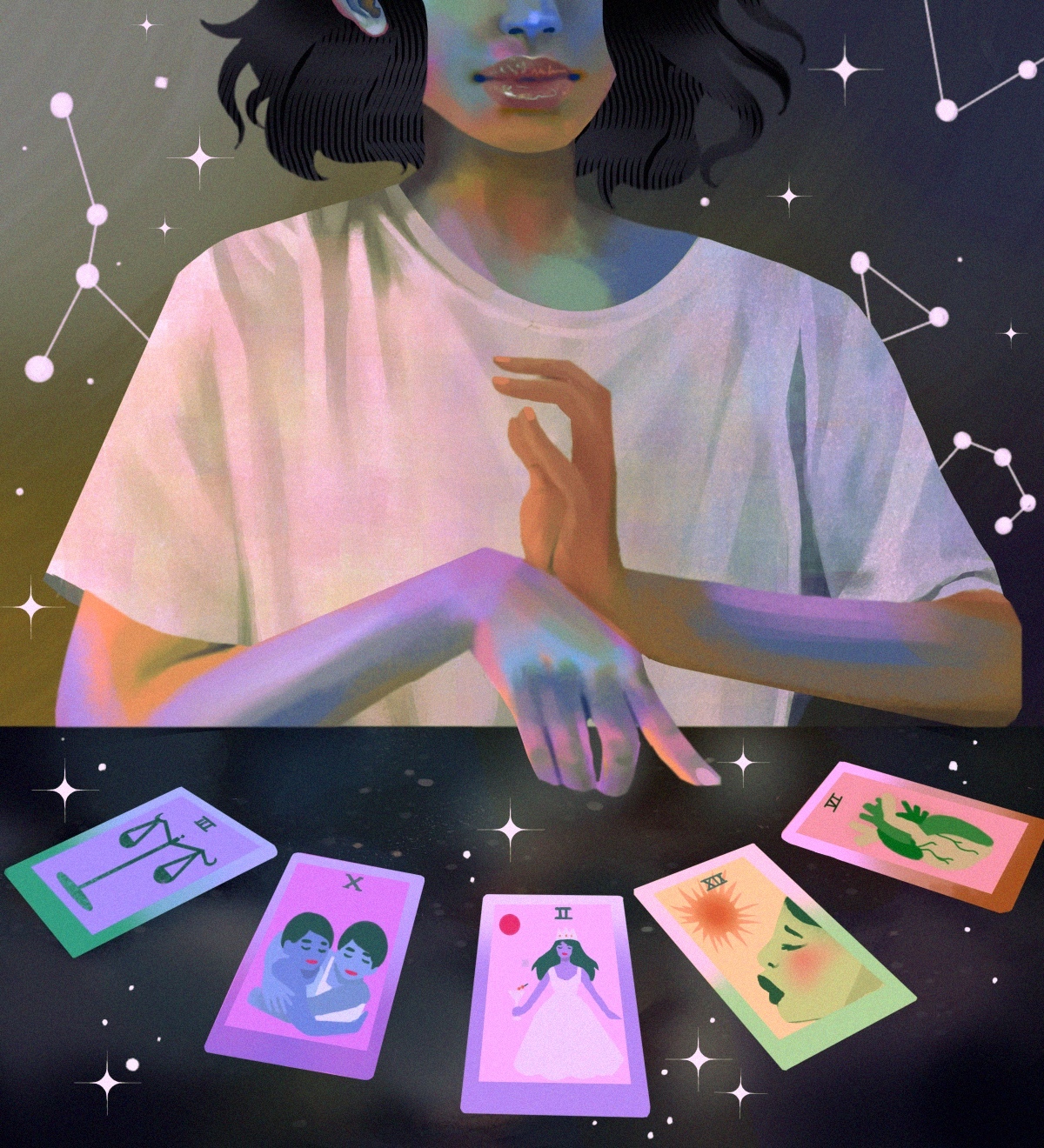Late on a Sunday night two Februarys ago, I flung an email into the cosmos. Misconduct allegations against a then close friend had capsized me. I thought of reaching out to my therapist, an expert with whom I could slowly work through the painful complexities of the matter, but the story seemed too convoluted to explain in a single fifty-minute session. Plus, her calendar was full, and my bank account was barren—an appointment, scheduled for weeks in the future, would have meant sacrificing groceries. Grasping for expeditious results, I instead contacted a nearby crystal-healing centre. Astrology, tarot, reiki, spiritual counselling, witchcraft, a spell—I was willing to try anything that might offer a semblance of comfort, however provisionary or mystical. I just needed someone to assure me this would pass.
I never did get a response to my email. Fortunately, on the internet, options abound. Horoscope.com told me that an “interesting new person” might come into my life and make things better, but that I should learn to set boundaries (good advice, but not quite what I was looking for). Sally Brompton, whose blunt horoscopes appear in the Globe and Mail and the New York Post, had written that cosmic activity in the career area of my chart would open up new paths over the coming days, and if I acted quickly, rewards and recognition would follow (intriguing, but not a fit). The Cut’s resident astrologer, Madame Clairevoyant, declared, “There’s joy that comes from sweeping change, and joy that comes from watering your plants and watching them thrive” (only now, years later, do I understand what she meant). Then I saw that Jessica Dore, a popular tarot card reader with more than 130,000 followers on Twitter alone, had posted her monthly offering a few weeks prior. Unlike the other clairvoyance content I clicked through that night, this gave me revelations I could cling to:
High Priestess reminds us that listening to intuition is not always easy.
When loss happens, discernment (The Magician) will help you sink to the bottom of that void (Five of Cups) . . . And it will help you to know when it’s time to come back up for air.
Cut off whatever is rubbing you raw or sapping your psychic energy, and don’t say sorry. If cutting feels too laborious, just say “yes” to more of the people and things that feed you. Starve the other stuff until it withers away.
Here it was, the guidance I was looking for—albeit guidance that required some tailoring to fit my circumstances. Hallelujah, I thought nonetheless, I feel seen.
Of course, I was not actually seen. I was in my apartment, alone, concerned and very sad. Dore’s reading felt restorative insofar as it alleviated those feelings, but it was not therapy, and Dore is not a therapist. On this particular night, I’m not sure the distinction mattered.
In recent years, there’s been a surge in the mainstream popularity of astrology and tarot, powered by smartphones and social media. In addition to the wave of mystical microcelebrities, like Madame Clairevoyant and Dore, there are many tech startups offering solace in a few quick swipes. Last year, the company behind the “hyper-personalized” astrology app Co-Star raised more than $5 million (US) in funding. (One backer later told the New York Times that she thought it could someday become as popular as Spotify or Tinder; by February, it already had a reported 7.5 million registered users.) Another app, Sanctuary, offers birth charts and daily horoscope readings sent by text. For $19.99 (US) a month, users can type in their questions and receive prompt responses. There’s also the Astrology & Palmistry Coach app, which, for a similar price, allows its reported 12-million-plus users to scan their hands for real-time palm readings. Not all answers come with a fee: at free-tarot-reading.net, users can click a few buttons to pull their cards and receive a spread from which to glean direction. (When I tried it, I pulled the Hanged Man: “Someone or something has to go.”)
With on-the-spot spiritual support available across the digital realm, anyone struggling through a rough patch of anxiety, uncertainty, lethargy, malaise, or any combination of relationship, family, and career troubles can access immediate feedback. Consequently, the line between spirituality and psychology is starting to blur. The result is an increasingly amorphous enterprise broadly categorized under the umbrella of online wellness, something we might call “fast spirituality”—quick, affordable hits of affirmation that help people get through the day.
Listen to an audio version of this story
For more audio from The Walrus, subscribe to AMI-audio podcasts on iTunes.
Fast spirituality is fun and trendy, and it can even be useful, but its growth may point to something more disconcerting: the inaccessibility of our mental health care systems. As many young people have discovered, the right therapist can be hard to find. There are often wait-lists, and after each session, there’s always a bill—in my experience, a fifty-minute appointment can cost around $180. It takes a lot of time—and money—to build trust with a professional and make progress as a person. Fast spirituality, on the other hand, can be instantaneous, prescriptive, soothing, and free. Is it really so surprising that more and more people treat their zodiac signs as diagnoses, replacing the long, difficult path of professional therapy with instructions from the cosmos?
Humans have long looked to the stars for knowledge. In ancient Chinese, Mesopotamian, and Egyptian cultures, people studied the sun’s activity for clues as to how their rulers would fare. Sumarians and Babylonians believed that the whereabouts of gods could be understood by paying attention to the skies. It was the Greeks who designed the zodiac system as we commonly know it today, with each sign, named after a constellation, corresponding to a specific time of year and associated with specific qualities.
For centuries, astrology and astronomy were one and the same. Throughout the Middle Ages, astrology was practised by doctors, astronomers, and mathematicians. Upon the discovery of gravity and further understanding of how the planets moved, however, astronomy became the dominant science, and astrology’s prominence declined as the scientific method set in. Astrologers became seen as superstitious practitioners of pseudoscience, and those who continued working began to do so under pseudonyms. Interest seemed to renew with the rise of nineteenth-century mysticism, and in the decades since, the popularity of horoscopes has grown. While there are numerous branches of astrology with varying cultural roots, their purposes have essentially been to predict the future based on interpretations of celestial cycles. Astrology’s spiritual cousin, tarot—just as in vogue—is now commonly used as a method of deepening our understanding of the present.
On social media, it’s tricky to gauge how much of the newfound popularity around “psychic services” comes from credulous believers and how much of it is pure entertainment. Massively popular Instagram accounts, like @Trashbag_Astrology (458,000 followers) and @thezodiacstea (1.2 million), among many others, combine lighthearted candour with rude awakenings by attributing messy behavioural patterns to specific astrological identities. “[Aquarius] bi**hes would do something like this and blame they horoscope,” read one recent post from the former, atop an image of a car somehow crashed into a second-floor window. Meanwhile, Los Angeles–based actor and comedian Benito Skinner posts a sketch on his Instagram at the beginning of every zodiac season, illuminating the highs and lows of the twelve signs. (Pisces: self-destructive problem drinker who cancels lunch to cry in the bath. Capricorn: career-obsessed and hostile, asks for the Wi-Fi password in a nice restaurant.)
These memes work because of the recognition that they elicit; even jokes intended to roast readers can make a person feel understood and forgiven. In this branch of humorous online astrology, the stars are more often used to justify lamentable actions previously committed than they are to forecast what’s to come. The ease with which people will preface the disclosures of their worst behaviour with “Not to be a total Leo, but” indicates that they may be overlooking the need for precisely the introspection and accountability that adequate mental health care can encourage over time—at, of course, a steep cost.
Still, spiritual modalities and beliefs can, and do, offer real insight to some. And there are many who interpret readings as workable advice, for better or worse. People end friendships, quit jobs, and make major life decisions because a horoscope or tarot interpretation posted to thousands of Twitter followers vaguely intimated that they should do so. This July, Dore posted the Two of Swords card to her account along with a reading: “We form alliance with our selves by choosing to trust, believe & validate our own experience. By telling the truth about what we think and feel, and being okay with the result of that truth telling. Even if others choose to leave. We retain a commitment to ourselves.” One reader thanked Dore for the validation and shared that they’d decided to follow her teaching by hitting pause on a difficult relationship. Another tweeted, “Thank u! I was waiting for a sign, I guess this is it.”
Dore has a master’s degree in social work, and in addition to the readings she publishes in her monthly newsletter and the daily cards she posts to Twitter, she also works with individual clients. In conversation, she’s clear on the line between mental health care and spiritual practices. “It’s not therapy,” she says of her tarot card reading. But, she notes, that doesn’t mean it can’t be helpful. Dore tries to avoid definitive language in her readings, words such as “always” and “never” that can nudge a person toward binary decision-making. “If someone sees a card and it inspires them to break up with their friend, that’s just part of their process,” says Dore. “They’re using the card as an object to validate the thing that they really want to do.”
She explains that the way she practises tarot is not about predicting the future: “It’s about helping people along in their process, helping them gain new perspectives or insights, helping them ask good questions, and helping them fortify their stories and their narrative so that they walk away from the session with something that feels empowering and reminds them of their agency and their strengths.”
Dore says that aligning tarot with mental health may help people think about their internal lives more openly, beyond traditionally clinical perimeters. Tarot, she argues, can influence one’s emotional state and does not purport to be diagnostic. “Most therapists understand that language and metaphor are used as tools. Tarot cards are just another way of sharing a metaphor with someone to help them better understand an internal experience,” Dore says. “One of the biggest arguments that someone might have against using tarot in mental health is that it’s not evidence based. There is no scientific rationale for why tarot works. But, for the people I use tarot cards with, it works . . . Does everything need to be evidence based in order for it to be valid? Does it need to be proven with the scientific method in order for us to take it seriously? I would strongly suggest that the answer is no.”
Minneapolis-based Claire Comstock-Gay, better known as Madame Clairevoyant, was hired by The Cut in 2016 to contribute weekly astrology readings. Since then, she has released a book (Madame Clairevoyant’s Guide to the Stars: Astrology, Our Icons, and Our Selves) and amassed a legion of readers, many of whom begin their weeks, as I often do, by turning to her advice.
Comstock-Gay’s horoscopes have an assured, nurturing tone that strikes a balance between encouraging and emboldening. “It’s important to me to never say, ‘And today you must go quit your job.’ That would be horrible, wild advice to be giving to all these people I don’t know at all,” she says. “I have a certain amount of trust that my readers are only going to take what works for them . . . I’m not interested in using astrology to make a person’s choices for them.”
Comstock-Gay acknowledges that there are readers for whom astrology may be a primary system of support. “I wonder how [astrology] would be different if therapy was affordable and accessible, both financially and bureaucratically,” she says. “Even if you can afford it, it’s really hard to find a therapist. It’s hard to find someone who will take your insurance, and it’s really hard to find someone whom you can get an appointment with in less than six months.”
Psychics and clairvoyants still elicit skepticism from many who find the practice far-fetched or even harmful. And fair enough—I remember sending a friend to a psychic in downtown Toronto only to later discover that the psychic had given the same reading to both of us. But those looking for self-improvement or solace can have less-than-ideal experiences with the more trusted routes of therapy too—a friend once told me that their therapist had spent half their session googling “readings to reduce anxiety.” Wellness practitioners of all kinds can have off days or be stumped. They can care only about money or be disengaged from their work. On paper, therapy may seem to be the antithesis of fast spirituality, but in practice, it isn’t so simple. Even an Instagram tarot card reader can offer an ethos, a sense of optimism, and paths toward acceptance—all virtues that many seek through therapy.
Toronto-based astrologer and tarot reader Liz Worth says that the tools she offers ought to be seen as complementary to therapy. “If you start working with a psychotherapist, there’s a long lead-up to talking about things that feel productive. There is a process behind that, whereas a [tarot or astrology] reading is a single-session, one-off touch point, and you can get right into it right away. You can cover a lot of ground that may feel very poignant or pressing, and that can be really beneficial for people.”
Worth stresses that there is a limit to the work she can do with clients—especially when it comes to traumatic experiences. “I don’t want to leave people feeling like a trauma happened to them for a reason. And I don’t want to use astrology to justify other people’s bad behaviour,” she says. “The person who caused that harm needs to be taken into account. We can’t say the planets made them do it.” Still, says Worth, the dynamic between a customer and a tarot reader may itself be therapeutic insofar as customers enter a nonjudgmental space to ponder questions they may not be able to articulate elsewhere.
Ultimately, what consumers of fast spirituality want is hope. “There are many things that remain totally mysterious, even to a clinician and even to science,” says Comstock-Gay, who cites the effect of trauma on the brain as one area in need of deeper research. “So why not use astrology if it’s helpful and if it works, which in a lot of cases it really does?”
The pursuit of wellness has become omnipresent. On social media, aspirations of inner peace are as visible as dreamy vacations, designer clothing, and chic interior design. Mental health terminology has burrowed into our lexicon, allowing us to have conversations about how we feel much more openly. But, while the idea of mental health is heavily promoted, access to it remains precarious, leaving many to rely on whatever succour they can find.
Online astrology is lucid enough to be astonishing, vague enough to be painless, and occasionally, galvanizing enough to cause trouble. Perhaps this is where it gets a bad reputation—it’s easier for some to view their struggles or deficiencies as fates designed by the zodiac or something to laugh off than it is to spend years working through their psyches on a quest for improvement. If fast spirituality is a valid form of wellness, shouldn’t it feel somewhat laborious, the way that therapy often does?
“To me, the tarot is a tool. It is therapy. It’s a teacher,” says Mexico-based psychic healer Tonya Melendez, who is currently working on her book, The Diary of a Black Psychic. “Tarot teaches us that we have to learn every aspect of ourselves—how we are with money, how we are with our emotions. That’s why having a reading can be so profound and healing for people.” When I ask Melendez if there is a limit to what tarot can heal, she says no, with an important caveat. “A lot of people don’t want to do the inner spiritual work for themselves, so they go to other people hoping that they’ll solve their problems. People want a quick, easy answer,” she says. “If there’s no follow-through or deeper connection, then it’s just emptiness—words that you believe for a little while.”
In many cases, responsible practitioners of fast spirituality are not promoting their services as a quick fix for life’s woes. But, on social media, horoscopes and forecasts are often consumed quickly and can be interpreted as fact even when they’re offered only as starting points for deeper thinking.
The key to healthily engaging with astrology, tarot, and other spiritual practices seems to be maintaining a sense of balance without relinquishing control. Magical thinking without discretion can make a person act rashly and against their best interests. So too can corporeality devoid of any hopeful soothsaying. A new duality is emerging in which one can be both a skeptic and a believer—spiritually lithe in the journey toward resilience.
But I would say that. I’m a Gemini.






